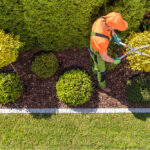Read Our Lawn Care Checklist For Minnesota Homeowners
With our tasty chili recipes, Minnesota homeowners know how to throw great backyard parties in fall — but how to get your yard ready for visitors? Our 10-point fall lawn care checklist has you covered.
From raking leaves to aerating soil, we’ll show you how to keep your lawn looking good into the fall and help your trees and plants to weather the cold, snow, and ice.
1. Rake the Leaves
Even with winter around the corner, your Minnesota grass is still growing in fall. Ignoring a thick layer of autumn leaves won’t do your turf any good, no matter how pretty the fall colors might look in your yard. A thick leaf layer blocks photosynthesis, invites pests and disease, and can even kill your turf.
Why you should rake the leaves: Keeping your turf clear of leaves will help ensure your grass gets the best opportunity for growth before cold winter arrives.
But doesn’t grass grow in summer? As a Minnesota local, chances are good your turf is a cool-season grass. If that’s the case, your turf’s active growing seasons are spring and fall.
How often should you rake? Rake the leaves every few days if you can, even sooner if the leaves are wet.
2. Aerate Compacted Soil
Core aeration gives your turf plenty of oxygen, water, and nutrients to prepare for the winter.
When should you aerate your yard? Aerating the lawn during the turf’s growing season allows the turf to heal after the treatment quickly. For your cool-season grass, that means aerating in fall and avoiding the job in summer.
How often do you need to aerate your soil? Most lawns only need aeration once per year, though some may need it more if compaction is severe.
3. Remove Excess Thatch
A thatch layer less than ½-inch is healthy for the yard, as it acts as mulch for the grass and helps retain moisture. But a thatch layer over ½-inch isn’t so healthy, and you should have it removed.
Why you should remove excess thatch: Not removing thatch buildup could result in pests and diseases investing in thatch real estate for their winter home.
When should you remove excess thatch? Early fall is the optimal time to dethatch cool-season grasses because the growing season allows the turf to heal before dormancy.
How do you dethatch your yard? You can dethatch the yard with many different tools, such as a power rake or verticutter, or with the help of a hired professional.
4. Overseed Your Lawn
At the end of the summer, your yard might have a few patchy areas where the kids played soccer or swung on the swings. Fall is the perfect season to overseed these areas, as the temperatures are just right for cool-season grasses to begin germination.
How to overseed your lawn: Plant grass seed at least 45 days before the first frost.
How overseeding works: The grass seed grows, filling in your lawn. The end result? Those brown patches won’t be as much of an eyesore come springtime.
5. Prep the Flower Beds for the Cold
Attractive flower beds can really wow the neighbors and would-be homebuyers, but fall is the time to prep these landscape features for winter.
Why prepping your flower beds for winter is important: Your perennials will be especially vulnerable to winter pests and diseases, and your dead annuals won’t be returning next year.
Winterization steps include:
- Pull weeds
- Remove dead annuals
- Divide the perennials
- Insulate the beds with mulch
- Give the plants a big drink of water before cold temperatures arrive
6. Fertilize the Turf
After a hot summer, your grass needs an extra burst of strength if it’s going to survive the winter. Lather your healing grass with fertilizer in early autumn so that it has plenty of time to grow and recuperate before temperatures drop.
But don’t go dousing fertilizer willy-nilly. If you want the best-looking Minnesota lawn, you’re going to have to do some careful planning. Too much fertilizer can be unhealthy for your turf. And different turf types and soil types need different fertilizer regimens.
Before you fertilize your lawn, get a soil test: Conducting a soil test can be a great way to develop a fertilizer routine. You’ll discover what nutrients your soil is missing, pH imbalances, salt levels, and other soil deficiencies. A soil test will also reveal how you can remedy these problems with soil amenities and fertilizers.
What type of fertilizer does your yard need? Most turfs need a combination of nitrogen, phosphorus, and potassium. According to the Purdue Extension, applying a majority of nitrogen fertilizer to cool-season grass from late summer through fall promotes summer recovery, enhances color, increases root density, and prepares the turf for winter.
7. Apply Pre-emergent Herbicide
Cool temperatures won’t stop winter annual weeds from sprouting. Prevent henbit and chickweed from invading your lawn by applying a pre-emergent herbicide. Averting weeds helps minimize competition and ensures your turf doesn’t lose its food supply to these leech plants.
Pro Tip: Remember, pre-emergent herbicide must be applied before the weeds crop up. You should not use it to kill existing weeds. Apply a post-emergent herbicide instead if winter annual weeds are already growing in your Minnesota yard.
8. Time the Last Mow
You’ve probably heard that the last mow of the season should be low, and in some cases, that’s true. Keeping your grass too long in winter might cause unattractive matting and snow mold. But cutting too short prevents the turf from photosynthesizing and makes it susceptible to freezing temperatures.
What is an ideal height for the final mow of the season? An ideal grass height on the last mow is 2½ inches for most grasses. But keep in mind that 2½ inches may not be suitable for your type of grass. It’s essential to do your homework before cutting your grass shorter than usual.
What’s the one-third rule of grass height? Never cut more than one-third of the grass blade’s length. If cutting your grass down to 2½ inches means cutting more than one-third of the grass blade, then you should not mow low.
Why you don’t want to cut your grass too short: Mowing too much at once can stress the grass. Instead, lower the mowing blades gradually over a series of mows so that the last mow isn’t so harsh on the turf.
How do I know when the last mow is? Your cool-season grass will continue to grow in autumn. Once you notice the turf has stopped growing, it’s time for the last mow.
9. Continue to Water
Your turf needs water, whether it’s hot or cold outside. So if you’re headed to Oktoberfest this fall, you’ll need to ensure an automatic sprinkler waters the lawn or hope it rains.
When should you water your lawn in fall and winter? Water your grass only when temperatures are above 40 degrees. The air temperature might not be freezing, but cold winds can still make tiny droplets of water freeze on the grass.
Pro Tip: Most grass types need 1 to 1½ inches of water a week throughout the growing season and ½ inch of water a week throughout the dormant season. Remember that this will vary between grass types, as some grasses need more water than others.
10. Winterize the Irrigation System
If you don’t winterize your lawn’s irrigation system, the water left inside might freeze and damage the system.
When should you winterize your sprinkler system? Winterize the irrigation system before the first hard freeze.
How to winterize your irrigation system: Drain the irrigation system to ensure no leftover water freezes.
Why it’s important to winterize your irrigation system: A frozen irrigation system can lead to burst pipes, cracked plastic, broken sprinkler heads, and money down the drain. In other words, less present money for the holidays.
Fall Care Means Spring Flare
Fall lawn care might feel like an unnecessary backache now, but when the earth begins to thaw, and the birds begin to sing, you’ll finally see your efforts bloom. For the grass to survive the winter and burst forth in spring, it’s going to need nutrients, moisture, and protection against pests and disease.
Follow our 10-step fall lawn care checklist, and you’ll help your Minnesota lawn become the talk of the town — now all you need is a checklist to win the next chili cookoff!
Remember: If lawn care isn’t your favorite thing to do over the weekend, you can always hire a Minnesota lawn care pro near you.









